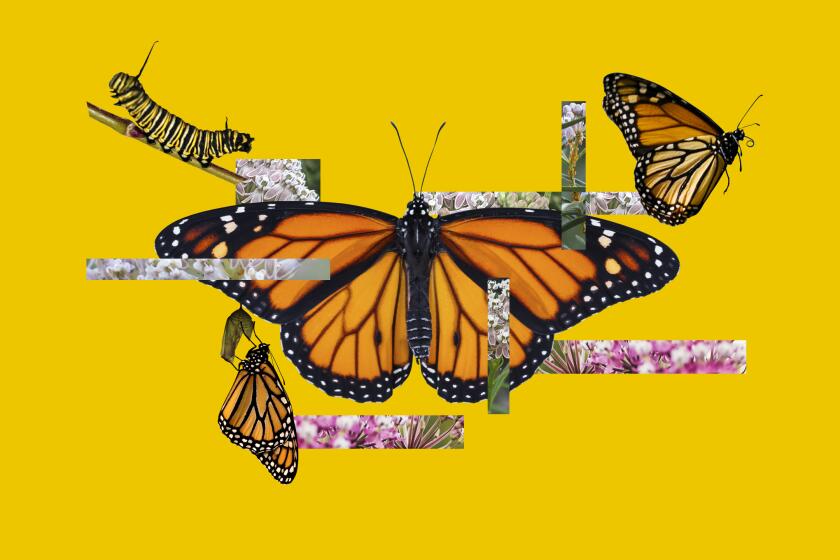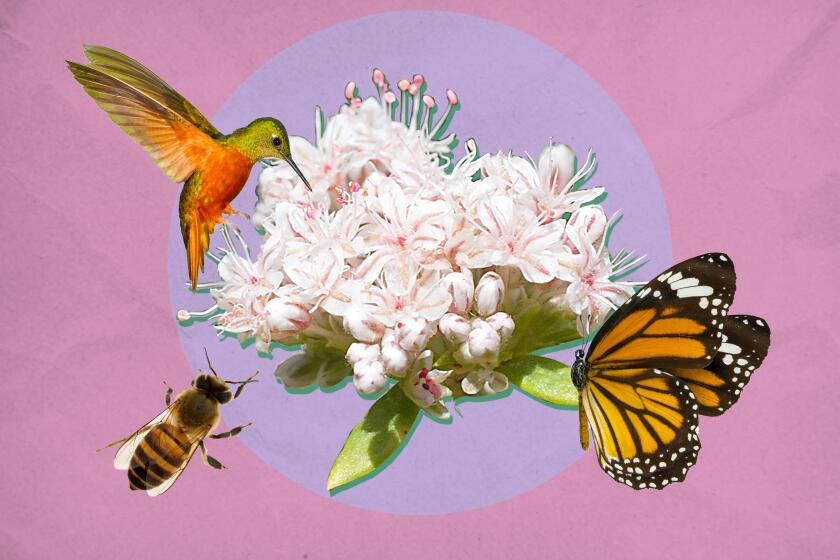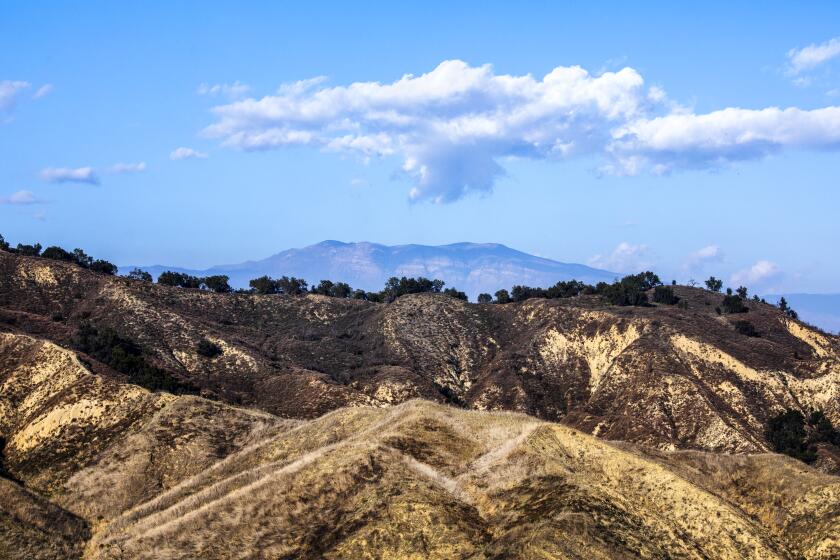Monarch butterfly fans are clamoring for native milkweed. Here are 8 places to buy it
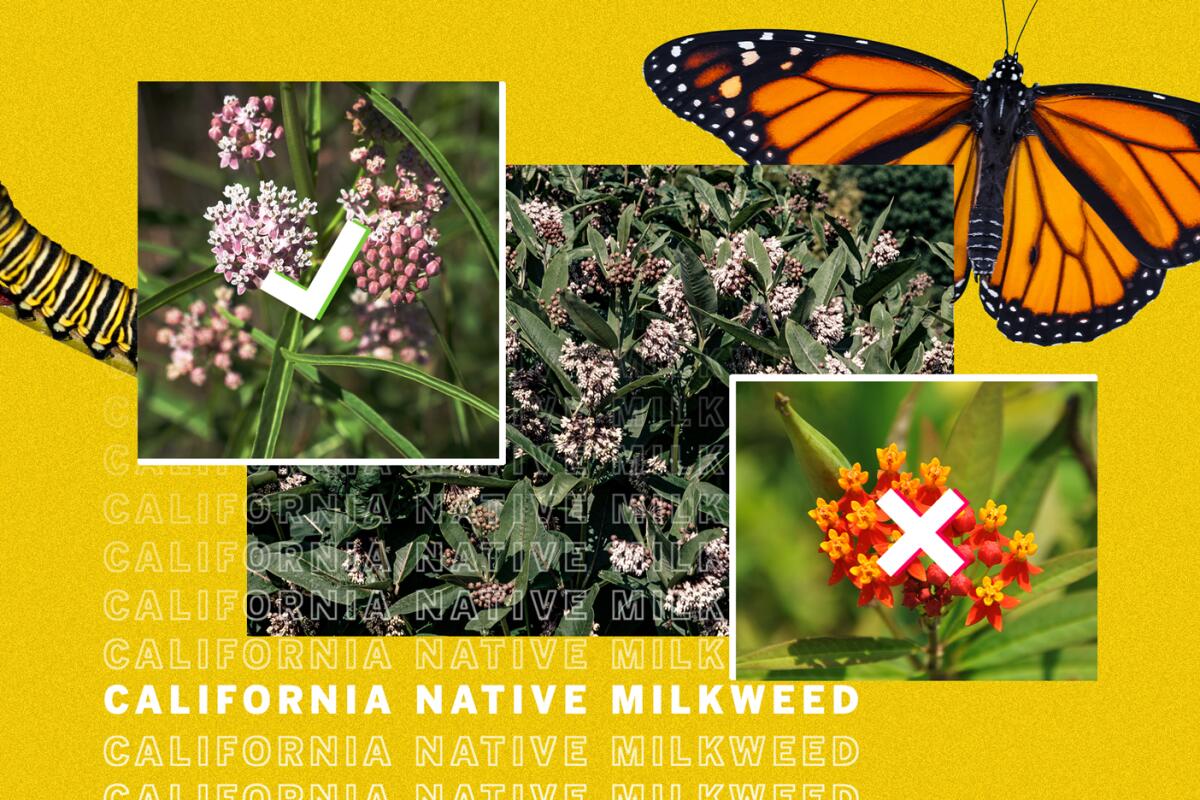
- Share via
Butterfly fans, take a breath. I know it’s officially spring and we’re all pounding on nursery doors, anxious to plant some California native milkweed to help the endangered Western monarch butterfly stay afloat since, yes, milkweed is the only thing its caterpillars will eat and nonnative varieties appear to be hastening its demise.
But here’s the thing: native milkweeds are still slowly coming back to life.
Native milkweeds — especially narrow-leaf milkweed, the most prominent variety in California — are just now emerging from dormancy, a normal, natural thing that won’t be hurried no matter how we plead, said Patty Roess, manager of the retail portion of the Tree of Life Nursery in San Juan Capistrano, one of Southern California’s premier growers of native plants. “We’ve tried growing native milkweed in different conditions and it’s the same. You can’t change what the plant wants to be: a summer bloomer that goes dormant in midwinter.”
Monarch butterfly populations are endangered, to the point that the 1.2 million Western monarchs counted in 1997 plummeted to fewer than 2,000 by 2020. Here are ways we can help them survive.
That means the plants big enough to sell won’t be available at most Southern California nurseries until mid-April — earlier if we get a couple of really warm weeks or later if the temperatures stay cool. And because of the heavy demand this year and lots of pre-orders, nursery managers are warning that it might be May or even early summer before they’ll have more native milkweed in stock.
“All our April crop is already reserved out — we’re talking hundreds of plants — and we’re already taking reservations for our May crop,” said Su Kraus, founder and advisor to Moosa Creek Nursery, a wholesale grower of California native plants in Valley Center near San Diego.
El Nativo Growers, a wholesale native plant grower in Azusa not open to the public, has seen such demand for native milkweed “that we sold out [to retailers] very, very early this season, before the plants even emerged from dormancy,” said co-owner James Campbell. “We’re trying to ramp up production.”
Some people are so eager that they’ve been buying pots of dormant narrow-leaf milkweed, a.k.a. Asclepias fascicularis, at the Santa Barbara Botanic Gardens nursery, says manager Matt Straka. “It looks like just dirt and maybe a twig, and sometimes there isn’t even a twig,” Straka said, “but if you pop the ‘plant’ out of the pot and see white roots along the edge of the soil, that’s a good sign it’s alive but in the dormant stage.”
All this demand is good news, right? Because people are really trying to help the migratory Western monarch whose numbers sank below 2,000 during last year’s Thanksgiving weekend count, down from the millions that used to winter on the California coast some 30 years ago.
The new wave in landscaping is building habitat by growing native plants, but you don’t need a yard to promote biodiversity. Hummingbirds, butterflies, bees and other pollinators are happy to dine on native plants growing on balconies or patios.
Since that disastrous count, the Xerces Society for Invertebrate Conservation has issued a “call to action,” outlining ways the public can help. And two bills were introduced in Congress in mid-March to help fund monarch habitat restoration and preservation.
Feel free to skip to the end, where we’ve listed eight places you can purchase milkweeds native to Southern California along with other flowering native plants that provide food for adult monarchs. Because of the demand, you may have to make an advance order at these locations or with your local nursery (lobby them hard if they don’t already sell native milkweed). And remember to be patient, since many nurseries are short staffed, beleaguered by phone calls and orders, and trying to deal with the evolving pandemic like the rest of us.
But if you’re a plant wonk like me, let’s talk about the complexity of the Western monarch situation and why a seemingly simple thing like milkweed poses such a challenging problem.
When things get unbalanced in the natural world, the “solutions” are often more complicated than we have time — or the inclination — to process, and they’re fluid. Researchers get new data and slowly develop new theories, but most of us are impatient. We want to act, do something to help, and we usually grab for the simplest solutions, not realizing that sometimes we’re just making things worse.
Consider milkweed for instance, the sole food for monarch caterpillars. Herbicides and weed eradication programs around roads and farmlands have decimated much of the wild milkweed in California.
People became concerned about the monarch’s plight and nursery wholesalers began growing lots of tropical milkweed (Asclepias curassavica) for Southern Californian gardeners decades ago. It’s one of the prettiest milkweed varieties, with long thin leaves and thick clusters of orange and yellow blooms, more like an ornamental plant than a classic weed. SoCal gardeners readily added the plants to their yards to help the butterflies and get a front-row seat to the wonder of metamorphosis, from tiny egg to caterpillar to cocoon to butterfly.
Which brings us to the reason why tropical milkweed is such a problem in Southern California. See, tropical milkweed works fine as caterpillar food in colder parts of the United States, when it dies back during the winter, killing any parasites that live on the plants. But in Southern California tropical milkweed stays green and blooming year round. Xerces Society researchers believe this evergreen milkweed confuses normal monarch migration and allows harmful microscopic parasites — Ophryocystis elektroscirrha, or OE — to multiply on the plants. Monarch caterpillars end up eating a lot of this nasty parasite as they devour the leaves and researchers believe OE is sickening the adults, messing up their lifespans, migration patterns and ability to reproduce.
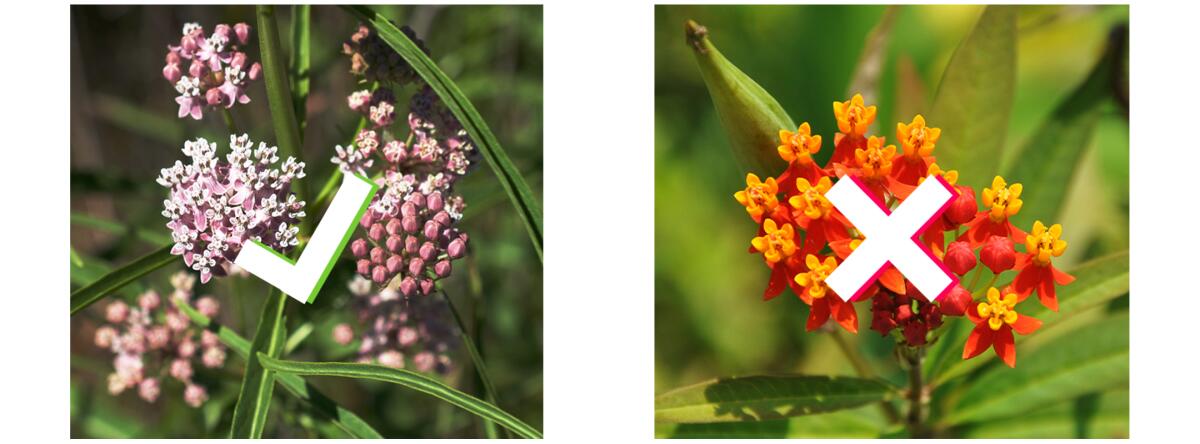
Remember: Pink is good, orange is bad
So in the simplest terms, butterfly experts say California native milkweeds, with their pink, white and cream-colored flowers are the only milkweeds we should be planting in Southern California, because they typically go dormant around December (meaning the tops of the plants die back but the roots stay alive), and regrow when things warm up in the spring, around April or May. In fact, one of the region’s largest nurseries, Roger’s Gardens in Corona del Mar stopped selling tropical milkweed completely a couple of years ago. The nursery only sells native milkweed now and will once again offer its milkweed exchange program sometime in April, giving customers one free narrow-leaf milkweed plant in exchange for a tropical milkweed plant they’ve pulled from their yard, says General Manager Ron Vanderhoff.
You can find a list and photos of the native milkweeds that grow best in your region on the Xerces Society website. Narrow-leaf is the most commonly offered plant at nurseries, but some might also have other varieties, such as the pink-flowered showy milkweed (Asclepias speciosa), woollypod milkweed (Asclepias eriocarpa) with its clusters of cream-colored blooms, and the purple-flowered California milkweed (Asclepias californica).
But NOT in coastal areas
The Xerces Society now warns against planting any milkweed in SoCal’s coastal areas because even native milkweeds stay green during the mild winters, allowing parasites to multiply. Instead, it recommends that people in coastal areas, especially within five miles of overwintering sites, focus on California native plants that bloom in the winter (November-January) and/or early spring (February-April), to provide nectar for the adult monarch butterflies when they need it most. (Interesting note from the Xerces Society’s publication Protecting California’s Butterfly Groves: Monarchs need temperatures of 55 degrees or higher to be able to fly, and can only crawl helplessly on the ground if they are unlucky enough to fall from their perch. This is why they tend to cluster on certain trees in mild coastal areas, looking for spots that shelter them from wind, rain and predators while still providing enough warmth in the day so they can fly to find food.)
The Ventura Land Trust recently opened the Harmon Canyon Preserve for free hiking and biking through oak groves, meadows and coastal and mountain views.
Organic only
It’s critical to make sure the native plants you buy are grown organically, without pesticides. Milkweeds are the monarch caterpillar’s sole food, but they are also a magnet to orange-colored aphids, which are unsightly but harmless to the plant and caterpillars, growers say. Some commercial growers use a systemic chemical pesticide on their milkweed to discourage aphids, but that also makes the plant toxic to the caterpillars. Customers need to be sure they’re buying from “specialized growers, who know how to control aphids without using harmful chemicals,” said Moosa Creek owner Jose Cohen.
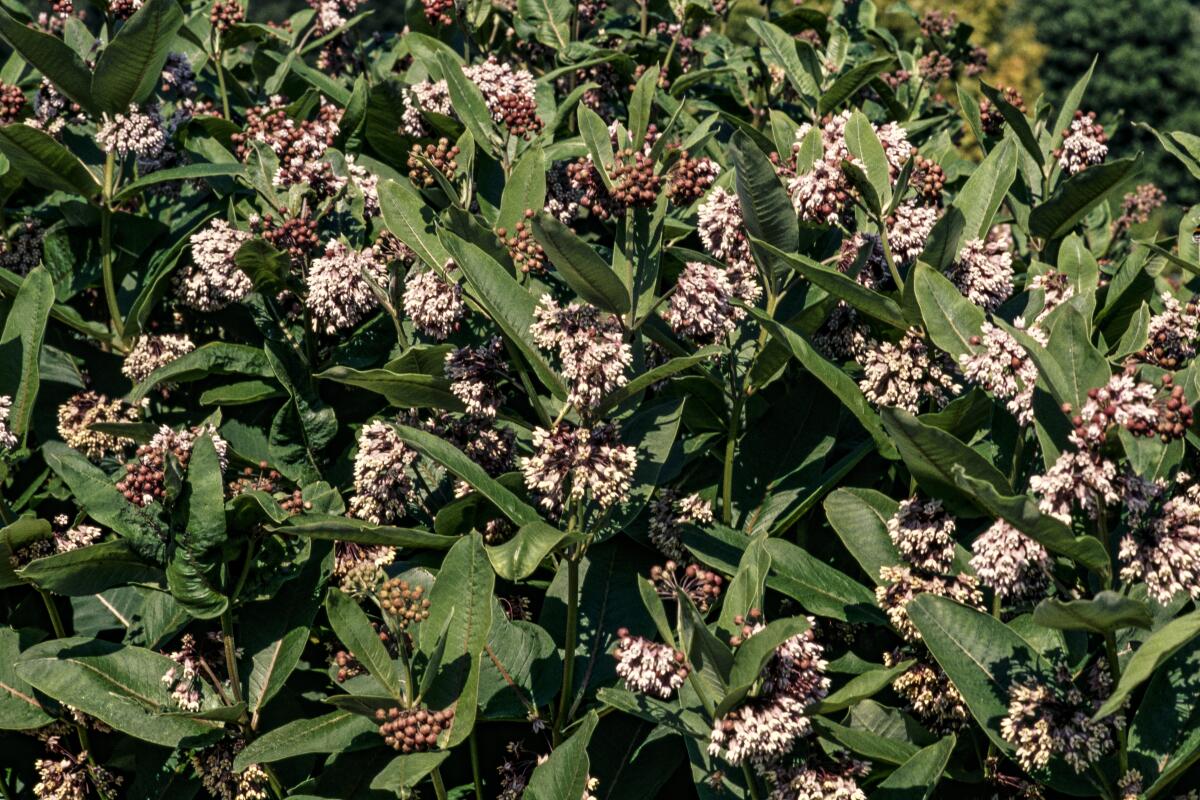
It’s food, not decoration
An important note here: Aphids might look yucky but remember, we’re planting native milkweed to create habitat for monarch caterpillars, not decorate our yards. “You’re not growing this for prize-winning flowers,” Straka says.
“People need to know that some bugs are OK to have but they should expect that the caterpillars and the aphids will totally decimate their narrow-leaf milkweed. They’re going to eat this thing to the stems, but that’s OK because it’s a food source.”
The good news is that gardeners should also be planting lots of nectar-producing native plants as well, to attract and sustain the monarch adults. So if you’re worried about bedraggled-looking milkweed in your yard, surround those plants with beautiful flowering native shrubs and perennials, such as buckwheats, salvias, sunflowers and yarrow. For more specifics, check out the Xerces Society’s list of native monarch nectar plants for California.
You can also check in with the Tree of Life Nursery about its butterfly bundle kits of six monarch-friendly native plants, coming May 3, and the Theodore Payne Foundation, which is selling $60 monarch habitat kits at its Sun Valley nursery with everything you need to grow narrow-leaf milkweed and three native nectar plants from seeds. (The kits are too heavy to ship, says director Evan Meyer, so they are only available at the store.)
Whether you’re looking for ocean views or desert landscapes or soaring mountain peaks, Los Angeles offers miles upon miles of strikingly different trails.
Where to buy
The following Southern California nurseries specialize in native plants and expect to have at least narrow-leaf milkweed available by mid-April. This is not a complete list; to check for more native plant growers in your area, visit the California Native Plant Society’s CalScape website and be sure to check in with your local retail nurseries to see whether and when they will be selling native milkweed and/or other flowering native plants.
Artemisia Nursery, 5068 Valley Blvd. in El Sereno, artemisianursery.com
California Botanic Garden Grow Native Nursery, 1500 N. College Ave. in Claremont, calbg.org
Hahamongna Native Plant Nursery, 4550 Oak Grove Drive in Pasadena, arroyoseco.org/nursery
Moosa Creek Nursery, Valley Center, near San Diego; wholesale grower not open to the public but does take special orders online delivered to a partner retailer. moosecreeknursery.com
Roger’s Gardens, 2301 San Joaquin Hills Road, Corona del Mar, rogersgardens.com
The Santa Barbara Botanic Garden nursery, 1212 Mission Canyon Road in Santa Barbara, sbbg.org
Theodore Payne Foundation nursery, 10459 Tuxford St. in Sun Valley, theodorepayne.org
Tree of Life Nursery, 33201 Ortega Highway in San Juan Capistrano, californianativeplants.com
More to Read
Sign up for The Wild
We’ll help you find the best places to hike, bike and run, as well as the perfect silent spots for meditation and yoga.
You may occasionally receive promotional content from the Los Angeles Times.
